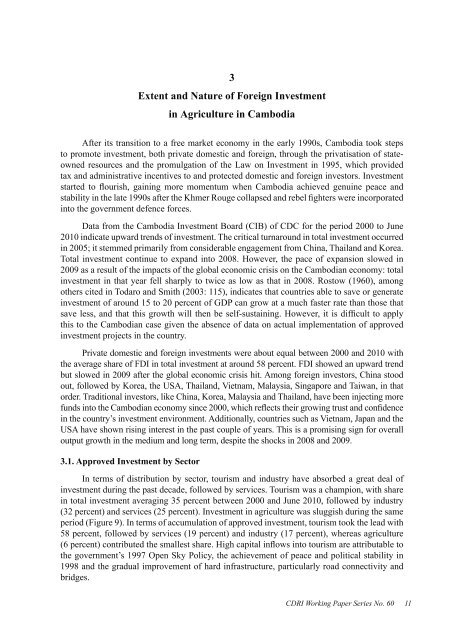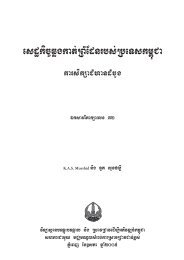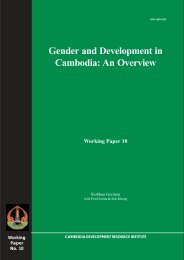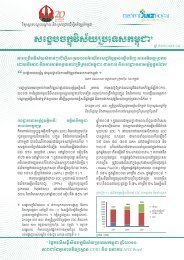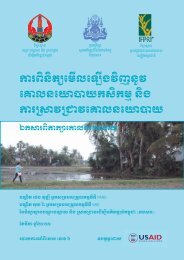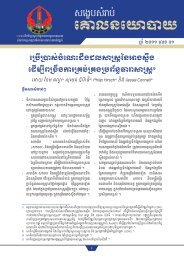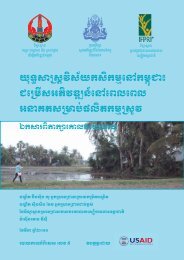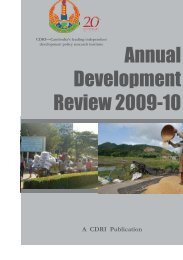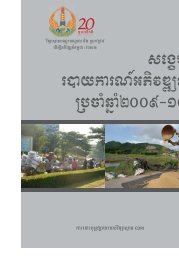Foreign Investment in Agriculture in Cambodia CDRI Working Paper ...
Foreign Investment in Agriculture in Cambodia CDRI Working Paper ...
Foreign Investment in Agriculture in Cambodia CDRI Working Paper ...
Create successful ePaper yourself
Turn your PDF publications into a flip-book with our unique Google optimized e-Paper software.
3<br />
Extent and Nature of <strong>Foreign</strong> <strong>Investment</strong><br />
<strong>in</strong> <strong>Agriculture</strong> <strong>in</strong> <strong>Cambodia</strong><br />
After its transition to a free market economy <strong>in</strong> the early 1990s, <strong>Cambodia</strong> took steps<br />
to promote <strong>in</strong>vestment, both private domestic and foreign, through the privatisation of stateowned<br />
resources and the promulgation of the Law on <strong>Investment</strong> <strong>in</strong> 1995, which provided<br />
tax and adm<strong>in</strong>istrative <strong>in</strong>centives to and protected domestic and foreign <strong>in</strong>vestors. <strong>Investment</strong><br />
started to flourish, ga<strong>in</strong><strong>in</strong>g more momentum when <strong>Cambodia</strong> achieved genu<strong>in</strong>e peace and<br />
stability <strong>in</strong> the late 1990s after the Khmer Rouge collapsed and rebel fighters were <strong>in</strong>corporated<br />
<strong>in</strong>to the government defence forces.<br />
Data from the <strong>Cambodia</strong> <strong>Investment</strong> Board (CIB) of CDC for the period 2000 to June<br />
2010 <strong>in</strong>dicate upward trends of <strong>in</strong>vestment. The critical turnaround <strong>in</strong> total <strong>in</strong>vestment occurred<br />
<strong>in</strong> 2005; it stemmed primarily from considerable engagement from Ch<strong>in</strong>a, Thailand and Korea.<br />
Total <strong>in</strong>vestment cont<strong>in</strong>ue to expand <strong>in</strong>to 2008. However, the pace of expansion slowed <strong>in</strong><br />
2009 as a result of the impacts of the global economic crisis on the <strong>Cambodia</strong>n economy: total<br />
<strong>in</strong>vestment <strong>in</strong> that year fell sharply to twice as low as that <strong>in</strong> 2008. Rostow (1960), among<br />
others cited <strong>in</strong> Todaro and Smith (2003: 115), <strong>in</strong>dicates that countries able to save or generate<br />
<strong>in</strong>vestment of around 15 to 20 percent of GDP can grow at a much faster rate than those that<br />
save less, and that this growth will then be self-susta<strong>in</strong><strong>in</strong>g. However, it is difficult to apply<br />
this to the <strong>Cambodia</strong>n case given the absence of data on actual implementation of approved<br />
<strong>in</strong>vestment projects <strong>in</strong> the country.<br />
Private domestic and foreign <strong>in</strong>vestments were about equal between 2000 and 2010 with<br />
the average share of FDI <strong>in</strong> total <strong>in</strong>vestment at around 58 percent. FDI showed an upward trend<br />
but slowed <strong>in</strong> 2009 after the global economic crisis hit. Among foreign <strong>in</strong>vestors, Ch<strong>in</strong>a stood<br />
out, followed by Korea, the USA, Thailand, Vietnam, Malaysia, S<strong>in</strong>gapore and Taiwan, <strong>in</strong> that<br />
order. Traditional <strong>in</strong>vestors, like Ch<strong>in</strong>a, Korea, Malaysia and Thailand, have been <strong>in</strong>ject<strong>in</strong>g more<br />
funds <strong>in</strong>to the <strong>Cambodia</strong>n economy s<strong>in</strong>ce 2000, which reflects their grow<strong>in</strong>g trust and confidence<br />
<strong>in</strong> the country’s <strong>in</strong>vestment environment. Additionally, countries such as Vietnam, Japan and the<br />
USA have shown ris<strong>in</strong>g <strong>in</strong>terest <strong>in</strong> the past couple of years. This is a promis<strong>in</strong>g sign for overall<br />
output growth <strong>in</strong> the medium and long term, despite the shocks <strong>in</strong> 2008 and 2009.<br />
3.1. Approved <strong>Investment</strong> by Sector<br />
In terms of distribution by sector, tourism and <strong>in</strong>dustry have absorbed a great deal of<br />
<strong>in</strong>vestment dur<strong>in</strong>g the past decade, followed by services. Tourism was a champion, with share<br />
<strong>in</strong> total <strong>in</strong>vestment averag<strong>in</strong>g 35 percent between 2000 and June 2010, followed by <strong>in</strong>dustry<br />
(32 percent) and services (25 percent). <strong>Investment</strong> <strong>in</strong> agriculture was sluggish dur<strong>in</strong>g the same<br />
period (Figure 9). In terms of accumulation of approved <strong>in</strong>vestment, tourism took the lead with<br />
58 percent, followed by services (19 percent) and <strong>in</strong>dustry (17 percent), whereas agriculture<br />
(6 percent) contributed the smallest share. High capital <strong>in</strong>flows <strong>in</strong>to tourism are attributable to<br />
the government’s 1997 Open Sky Policy, the achievement of peace and political stability <strong>in</strong><br />
1998 and the gradual improvement of hard <strong>in</strong>frastructure, particularly road connectivity and<br />
bridges.<br />
<strong>CDRI</strong> Work<strong>in</strong>g <strong>Paper</strong> Series No. 60<br />
11


